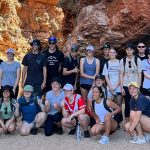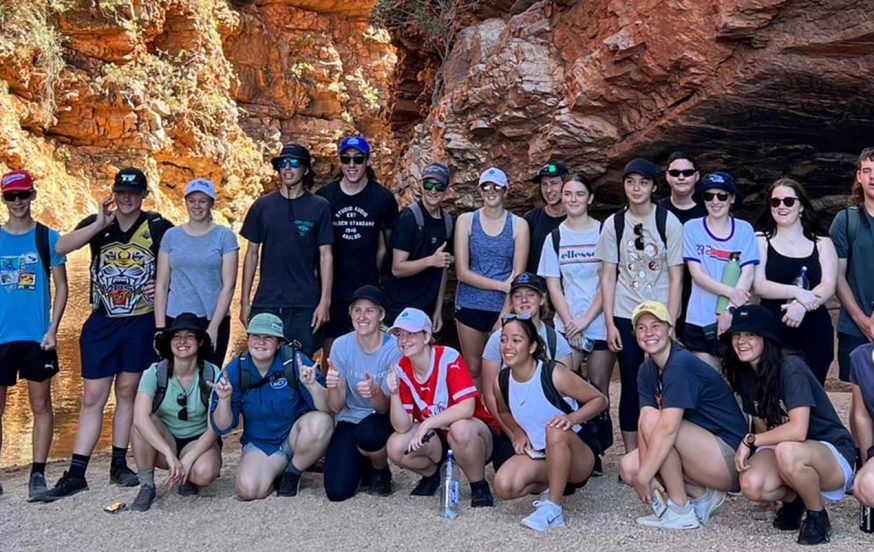The Northern Territory and Central Australia are one of our most popular destinations for school groups and it’s no surprise why. From exploring the most diverse landscapes in the country to being immersed in local First Nations communities, there’s so much to love about this magical slice of Australia. This handy travel guide designed specifically for teachers and students is full of tips that will help you plan your trip and pack your bags for the Northern Territory and Central Australia.
Northern Territory and Central Australia – Events and Attractions
Field of Light, Uluru – Now a permanent display, the Field of Light is an outdoor exhibition by internationally celebrated artist Bruce Munro. As darkness falls over Uluru, 50,000 spindles light up the desert covering more than seven football fields.
Mindil Beach Sunset Markets – This is Darwin’s biggest market, located along the beachfront with over 200 unique stalls, ranging from food stalls offering local and international cuisine to an array of arts, crafts and live performances. Mindil Beach Sunset Markets run from April to October and is open every Thursday and Sunday from 4pm to 9pm.
Uluru base walk – A trip to the Northern Territory and Central Australia really isn’t complete without seeing the magnificent Uluru. The perfect way to explore the area and absorb its majestic beauty is by walking around the base of the rock. Discover ancient stories, rock paintings, and caves that take you around the whole circumference (a 10km trail) or choose to concentrate on sections.
MacDonnell Ranges – The stunningly diverse West MacDonnell Ranges is famous for its breathtaking scenery, world-class hikes, swimming holes and natural treasures. Our students love to walk through Ormiston Gorge, take a dip in the waterhole and explore the trails and gorges at Standley Chasm and Simpson’s Gap.
Cultural immersion program – Experiencing a cultural immersion program in the NT is a must to gain an authentic insight into Indigenous history and culture. Students will be immersed in a local First Nations community, guided around areas of cultural significance, learn about Indigenous artefacts and bush tucker, and listen to dreamtime stories passed down from generation to generation.
Alice Springs Reptile Centre @ Night – This is a chance for students to get up close and personal with the fascinating reptiles that call the Northern Territory home. Accompanied by experienced handlers, students get to know these fascinating reptiles and get the opportunity to feed or handle them – if they dare!
Sunset at Ubirr Rock – Experiencing a sunset at Ubirr Rock is not to be missed. Overlooking the Nadab floodplain, watch the sun disappear while taking in the stunning landscape and reflecting on the history of the region.
Nitmiluk Cruise of the gorges – Embark on a journey through the stunning gorges in Nitmiluk National Park, where the outback meets the tropics. Make your way through the gorges and discover Aboriginal rock art while learning the ancient Aboriginal culture of the area.
Northern Territory and Central Australia – Climate
The Northern Territory stretches approximately 1600km from top to bottom, covering two distinct climate zones – the tropical Top End (Darwin, Katherine, Kakadu and Arnhem Land) located in the north half and the dry semi-arid Red Centre/Central Australia (Alice Springs, Tennant Creek and the Uluru region) is located in the southern half.
Top end | Two seasons
The dry season (May to October) is generally the most popular time to travel as it has the most comfortable weather conditions (21°C to 32°C) and there’s little rain.
The wet season, also known as a tropical summer (November – April) is very humid and is the time most likely to have tropical cyclones, monsoonal rains, and storms. This is still a beautiful time to visit as nature and the land comes alive.
Red Centre, Central Australia | Four seasons
The Red Centre experiences the same four seasons as most of Australia.
Summer (December-February) has average temperatures ranging between 20°C and 35°C and January is the wettest month.
Autumn (March-May) has average temperatures of 12°C to 27°C and is considered the best time to visit, as the days are warm and the nights cool.
Winter (June-August) temperatures range from 3°C to 20°C, with overnight temperatures dropping below freezing.
Spring (September-November) is a pleasant 14°C to 30°C.
We recommend that our groups travel between March and November and avoid the extreme conditions of summer/the wet season.
Northern Territory and Central Australia – Time Zone
The time zone in Northern Territory is ACST – Australian Central Standard Time UTC/GMT +9:30 hours
Packing list
Layers – The Northern Territory and Central Australia are known for its cooler nights, be sure to pack multiple layers to keep warm especially if you’re camping.
Comfortable shoes –You’ll be doing a lot of bush walking in the Outback, so don’t forget to pack a comfortable pair of shoes you can wear all day while hiking and exploring the sights.
Here is a general list of items we recommend packing for your trip:
General |
Clothing |
| Camera | Jeans/pants |
| Games/cards | Shorts |
| Torch | Jumper and warm clothes (for the cooler nights) |
| Sunglasses | T-shirts |
| Toiletries | Raincoat/jacket |
| Bath towel/beach towel | Underwear/socks |
| Sleeping bag and pillow | Bathers |
| Eating utensils | Sandals/slides |
| Reusable water bottle | Rubber-soled comfortable walking shoes |
Northern Territory and Central Australia fun facts
- Uluru is taller than the Eiffel Tower standing 348 metres.
- There are over 150 indigenous languages spoken
- Alice Springs is the Australian town closest to every beach in the country!
Learn more about the Northern Territory and Central Australia in our 10 interesting facts article.
To find out more about WorldStrides school trips to the Outback, check out our Northern Territory itinerary and our Central Australia itinerary, or contact us to speak with our Program experts.



